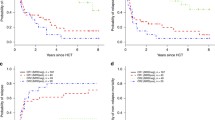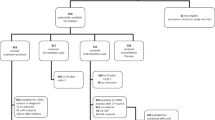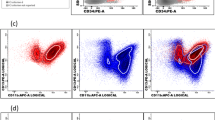Abstract
Either WT1 or leukemia-associated aberrant immune phenotypes (LAIPs) was one of the minimal residual disease (MRD) parameters used to predict leukemia relapse after allogeneic hematopoietic stem cell transplantation (allo-HSCT). We first evaluated the clinical value of various positive MRD standards for accurately indicating relapse based on WT1 and FCM data in adult patients with acute leukemia (AL). In total, 824 AL patients treated with allo-HSCT were enrolled in this study. We compared the sensitivity and specificity of diverse, multiple-criteria MRD prognostic standards based on WT1 and FCM assays. Higher sensitivity was achieved without a loss of specificity when MRDco+, which was defined as two consecutive WT10.6+ or FCM+ or both WT10.6+ and FCM+ in the same sample within a year posttransplantation, was used as the positive MRD standard. Similar results were observed, even in 484 patients who had both abnormal WT1 and LAIPs values before transplant. A multivariate analysis showed that MRDco+ was an independent risk factor for leukemia relapse after transplant in both acute myeloid leukemia (AML) and acute lymphoblastic leukemia (ALL). The combined use of FCM and WT1 monitoring could distinguish between patients with low and high risks of relapse. Various positive MRD standards were useful for guiding intervention.

Similar content being viewed by others
References
Germing U, Lauseker M, Hildebrandt B, Symeonidis A, Cermak J, Fenaux P, Kelaidi C, Pfeilstocker M, Nosslinger T, Sekeres M, Maciejewski J, Haase D, Schanz J, Seymour J, Kenealy M, Weide R, Lubbert M, Platzbecker U, Valent P, Gotze K, Stauder R, Blum S, Kreuzer KA, Schlenk R, Ganser A, Hofmann WK, Aul C, Krieger O, Kundgen A, Haas R, Hasford J, Giagounidis A (2012) Survival, prognostic factors and rates of leukemic transformation in 381 untreated patients with MDS and del(5q): a multicenter study, Leukemia 26:1286–1292
Shimazu T, Iida R, Zhang Q, Welner RS, Medina KL, Alberola-Lla J, Kincade PW (2012) CD86 is expressed on murine hematopoietic stem cells and denotes lymphopoietic potential. Blood 119:4889–4897
Tokunaga T, Shimada K, Yamamoto K, Chihara D, Ichihashi T, Oshima R, Tanimoto M, Iwasaki T, Isoda A, Sakai A, Kobayashi H, Kitamura K, Matsue K, Taniwaki M, Tamashima S, Saburi Y, Masunari T, Naoe T, Nakamura S, Kinoshita T (2012) Retrospective analysis of prognostic factors for angioimmunoblastic T-cell lymphoma: a multicenter cooperative study in Japan. Blood 119:2837–2843
Grimwade D, Hills RK, Moorman AV, Walker H, Chatters S, Goldstone AH, Wheatley K, Harrison CJ, Burnett AK, National Cancer Research Institute Adult Leukaemia Working Group (2010) Refinement of cytogenetic classification in acute myeloid leukemia: determination of prognostic significance of rare recurring chromosomal abnormalities among 5876 younger adult patients treated in the United Kingdom Medical Research Council trials. Blood 116:354–365
Bacher U, Haferlach T, Fehse B, Schnittger S, Kroger N (2011) Minimal residual disease diagnostics and chimerism in the post-transplant period in acute myeloid leukemia. TheScientificWorldJOURNAL 11:310–319
Stone JH, Patel VI, Oliveira GR, Stone JR (2012) Case records of the Massachusetts General Hospital. Case 38-2012. A 60-year-old man with abdominal pain and aortic aneurysms. N Engl J Med 367:2335–2346
Schultz KR, Pullen DJ, Sather HN, Shuster JJ, Devidas M, Borowitz MJ, Carroll AJ, Heerema NA, Rubnitz JE, Loh ML, Raetz EA, Winick NJ, Hunger SP, Carroll WL, Gaynon PS, Camitta BM (2007) Risk- and response-based classification of childhood B-precursor acute lymphoblastic leukemia: a combined analysis of prognostic markers from the Pediatric Oncology Group (POG) and Children's Cancer Group (CCG). Blood 109:926–935
Borowitz MJ, Devidas M, Hunger SP, Bowman WP, Carroll AJ, Carroll WL, Linda S, Martin PL, Pullen DJ, Viswanatha D, Willman CL, Winick N, Camitta BM (2008) Clinical significance of minimal residual disease in childhood acute lymphoblastic leukemia and its relationship to other prognostic factors: a Children's Oncology Group study. Blood 111:5477–5485
Inoue D, Maruoka H, Takahashi T (2010) Clinical analysis and optimization of postremission therapy for acute myeloid leukemia patients with minimal residual disease as determined by flow cytometry. Mediterr J Hematol Infect Dis 2:e2010020
Campana D (2012) Should minimal residual disease monitoring in acute lymphoblastic leukemia be standard of care? Curr Hematol Malig Rep 7:170–177
Buccisano F, Maurillo L, Del Principe MI, Del Poeta G, Sconocchia G, Lo-Coco F, Arcese W, Amadori S, Venditti A (2012) Prognostic and therapeutic implications of minimal residual disease detection in acute myeloid leukemia. Blood 119:332–341
Walter RB, Gooley TA, Wood BL, Milano F, Fang M, Sorror ML, Estey EH, Salter AI, Lansverk E, Chien JW, Gopal AK, Appelbaum FR, Pagel JM (2011) Impact of pretransplantation minimal residual disease, as detected by multiparametric flow cytometry, on outcome of myeloablative hematopoietic cell transplantation for acute myeloid leukemia. J Clin Oncol 29:1190–1197
Bruggemann M, Raff T, Kneba M (2012) Has MRD monitoring superseded other prognostic factors in adult ALL? Blood 120:4470–4481
Menssen HD, Renkl HJ, Rodeck U, Maurer J, Notter M, Schwartz S, Reinhardt R, Thiel E (1995) Presence of Wilms' tumor gene (wt1) transcripts and the WT1 nuclear protein in the majority of human acute leukemias. Leukemia 9:1060–1067
Sugiyama H (1998) Wilms tumor gene (WT1) as a new marker for the detection of minimal residual disease in leukemia. Leuk Lymphoma 30:55–61
Cilloni D, Saglio G (2004) WT1 as a universal marker for minimal residual disease detection and quantification in myeloid leukemias and in myelodysplastic syndrome. Acta Haematol 112:79–84
Trka J, Kalinova M, Hrusak O, Zuna J, Krejci O, Madzo J, Sedlacek P, Vavra V, Michalova K, Jarosova M, Stary J, Czech Paediatric Haematology Working Group (2002) Real-time quantitative PCR detection of WT1 gene expression in children with AML: prognostic significance, correlation with disease status and residual disease detection by flow cytometry. Leukemia 16:1381–1389
Zhao XS, Liu YR, Zhu HH, Xu LP, Liu DH, Liu KY, Huang XJ (2012) Monitoring MRD with flow cytometry: an effective method to predict relapse for ALL patients after allogeneic hematopoietic stem cell transplantation. Ann Hematol 91:183–192
Jin S, Liu DH, Xu LP, Chen H, Chen YH, Qin YZ, Liu YR, Liu KY, Huang XJ (2008) The significance of dynamic detection of WT1 expression on patients of hematologic malignancy following allogeneic hematopoietic stem cell transplantation. Zhonghua Nei Ke Za Zhi 47:578–581
Yan CH, Liu DH, Liu KY, Xu LP, Liu YR, Chen H, Han W, Wang Y, Qin YZ, Huang XJ (2012) Risk stratification-directed donor lymphocyte infusion could reduce relapse of standard-risk acute leukemia patients after allogeneic hematopoietic stem cell transplantation. Blood 119:3256–3262
Huang XJ, Liu DH, Liu KY, Xu LP, Chen H, Han W, Chen YH, Wang JZ, Gao ZY, Zhang YC, Jiang Q, Shi HX, Lu DP (2006) Haploidentical hematopoietic stem cell transplantation without in vitro T-cell depletion for the treatment of hematological malignancies. Bone Marrow Transplant 38:291–297
Huang XJ, Wang Y, Liu DH, Xu LP, Chen H, Chen YH, Han W, Shi HX, Liu KY (2008) Modified donor lymphocyte infusion (DLI) for the prophylaxis of leukemia relapse after hematopoietic stem cell transplantation in patients with advanced leukemia—feasibility and safety study. J Clin Immunol 28:390–397
Zhao XS, Jin S, Zhu HH, Xu LP, Liu DH, Chen H, Liu KY, Huang XJ (2012) Wilms' tumor gene 1 expression: an independent acute leukemia prognostic indicator following allogeneic hematopoietic SCT. Bone Marrow Transplant 47:499–507
Beillard E, Pallisgaard N, van der Velden VH, Bi W, Dee R, van der Schoot E, Delabesse E, Macintyre E, Gottardi E, Saglio G, Watzinger F, Lion T, van Dongen JJ, Hokland P, Gabert J (2003) Evaluation of candidate control genes for diagnosis and residual disease detection in leukemic patients using 'real-time' quantitative reverse-transcriptase polymerase chain reaction (RQ-PCR)—a Europe against cancer program. Leukemia 17:2474–2486
Gabert J, Beillard E, van der Velden VH, Bi W, Grimwade D, Pallisgaard N, Barbany G, Cazzaniga G, Cayuela JM, Cave H, Pane F, Aerts JL, De Micheli D, Thirion X, Pradel V, Gonzalez M, Viehmann S, Malec M, Saglio G, van Dongen JJ (2003) Standardization and quality control studies of 'real-time' quantitative reverse transcriptase polymerase chain reaction of fusion gene transcripts for residual disease detection in leukemia—a Europe Against Cancer program. Leukemia 17:2318–2357
Tamaki H, Mishima M, Kawakami M, Tsuboi A, Kim EH, Hosen N, Ikegame K, Murakami M, Fujioka T, Masuda T, Taniguchi Y, Nishida S, Osumi K, Soma T, Oji Y, Oka Y, Kawase I, Sugiyama H, Ogawa H (2003) Monitoring minimal residual disease in leukemia using real-time quantitative polymerase chain reaction for Wilms tumor gene (WT1). Int J Hematol 78:349–356
Thomas ED, Storb R, Clift RA, Fefer A, Johnson L, Neiman PE, Lerner KG, Glucksberg H, Buckner CD (1975) Bone-marrow transplantation (second of two parts). N Engl J Med 292:895–902
Bader P, Hancock J, Kreyenberg H, Goulden NJ, Niethammer D, Oakhill A, Steward CG, Handgretinger R, Beck JF, Klingebiel T (2002) Minimal residual disease (MRD) status prior to allogeneic stem cell transplantation is a powerful predictor for post-transplant outcome in children with ALL. Leukemia 16:1668–1672
Buckley SA, Appelbaum FR, Walter RB (2012) Prognostic and therapeutic implications of minimal residual disease at the time of transplantation in acute leukemia. Bone Marrow Transplant. doi: 10.1038/bmt.2012.139
Huang XJ, Liu DH, Liu KY, Xu LP, Chen YH, Wang Y, Han W, Chen H (2008) Modified donor lymphocyte infusion after HLA-mismatched/haploidentical T cell-replete hematopoietic stem cell transplantation for prophylaxis of relapse of leukemia in patients with advanced leukemia. J Clin Immunol 28:276–283
Jacobsohn DA, Tse WT, Chaleff S, Rademaker A, Duerst R, Olszewski M, Huang W, Chou PM, Kletzel M (2009) High WT1 gene expression before haematopoietic stem cell transplant in children with acute myeloid leukaemia predicts poor event-free survival. Br J Haematol 146:669–674
Hamalainen MM, Kairisto V, Juvonen V, Johansson J, Auren J, Kohonen K, Remes K, Salmi TT, Helenius H, Pelliniemi TT (2008) Wilms tumour gene 1 overexpression in bone marrow as a marker for minimal residual disease in acute myeloid leukaemia. Eur J Haematol 80:201–207
Lapillonne H, Renneville A, Auvrignon A, Flamant C, Blaise A, Perot C, Lai JL, Ballerini P, Mazingue F, Fasola S, Dehee A, Bellman F, Adam M, Labopin M, Douay L, Leverger G, Preudhomme C, Landman-Parker J (2006) High WT1 expression after induction therapy predicts high risk of relapse and death in pediatric acute myeloid leukemia. J Clin Oncol 24:1507–1515
Qin Y, Zhu H, Jiang B, Li J, Lu X, Li L, Ruan G, Liu Y, Chen S, Huang X (2009) Expression patterns of WT1 and PRAME in acute myeloid leukemia patients and their usefulness for monitoring minimal residual disease. Leuk Res 33:384–390
Busse A, Gokbuget N, Siehl JM, Hoelzer D, Schwartz S, Rietz A, Thiel E, Keilholz U (2009) Wilms' tumor gene 1 (WT1) expression in subtypes of acute lymphoblastic leukemia (ALL) of adults and impact on clinical outcome. Ann Hematol 88:1199–1205
Hu SY, Gu WY, Chen ZX, Wang XL, Cen JN, He HL, Chai YH, Chen CS (2010) The significance of detecting WT1 expression in childhood acute leukemias. Pediatr Hematol Oncol 27:581–591
Acknowledgment
The authors thank American Journal Experts (www.journalexperts.com) for their assistance in editing this manuscript.
Grant support
This work was supported by the National Natural Science Foundation of China (grant no. 30971292), National High-Tech R&D Program of China (863 Program 2010–2014), Leading Program of Clinical Faculty accredited by the Ministry of Health of China (2010–2012), and Beijing Key Laboratory for Hematopoietic Stem Cell Transplantation.
Conflict of interest
The authors declare that they have no conflict of interest.
Author information
Authors and Affiliations
Corresponding author
Electronic supplementary material
Below is the link to the electronic supplementary material.
ESM 1
(DOCX 14 kb)
Rights and permissions
About this article
Cite this article
Zhao, Xs., Yan, Ch., Liu, Dh. et al. Combined use of WT1 and flow cytometry monitoring can promote sensitivity of predicting relapse after allogeneic HSCT without affecting specificity. Ann Hematol 92, 1111–1119 (2013). https://doi.org/10.1007/s00277-013-1733-1
Received:
Accepted:
Published:
Issue Date:
DOI: https://doi.org/10.1007/s00277-013-1733-1




